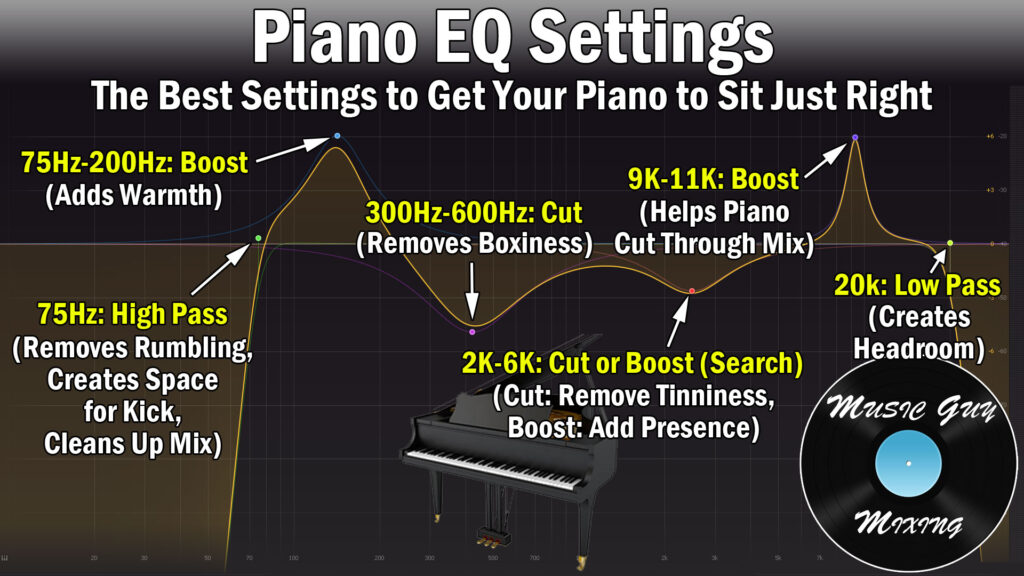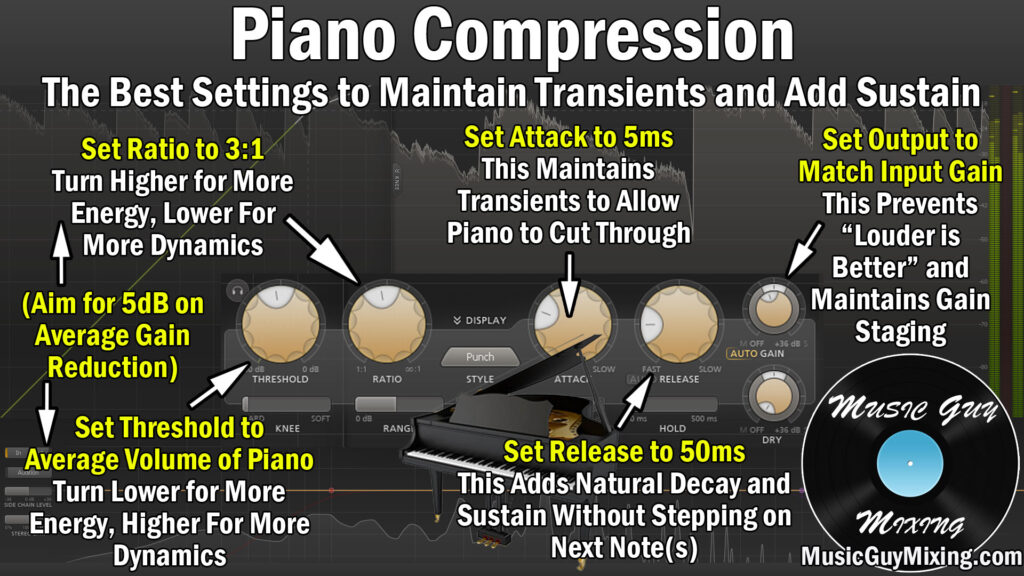Piano can play a variety of roles in your mix. Sometimes it’s in the foreground of a sparser mix (think Adele), sometimes it’s more of just an accenting piece to the point where you barely hear it. Regardless of how you’re using it in your mix, let’s talk how to mix piano with 7 tips.
How to Mix Piano
Let’s cover each of this piano mixing tips from the start to finish relative to your signal chain to get your piano sitting just right in your mix.

Cut Mud
When you think of that clean and sleek sound of piano in your favorite mixes, a lot of that comes from a healthy cut of the boxy frequencies.
The mix mud on piano exists in the 300-600Hz region (just be wary of the notes D4 to D5 which exist through here). A small cut here can help to give your piano that sheen that you hear in pro mixes.
This was one of many adjustments I recommended in my piano EQ guide.

Boost Transients
Transients are what help an instrument cut through the mix.
The transients of the piano come from that attack of hammers on strings. It’s this percussive sound which hits our ears first and subconsciously trains our ears to listen for the body and note itself of the keys.
This exists in the 9k region on piano, so we can bring out more of that percussiveness with a boost like shown above.
This is where I start when I feel like the piano is disappearing in the mix even when you feel like you have the level set correctly.
Compress for Sustain
Another good way to keep your piano powerful and present in the mix is through some effective piano compression.

It doesn’t take an aggressive ratio to achieve the sustain you want. In fact less is more as I like a ratio of 3:1 along with setting the threshold to the average volume of the piano.
Set the attack to 5ms to allow the aforementioned transients to cut through before you get the grip on the signal for the sustain we want with 50ms of release to recover transparently and without leaving the compression engaged too long. These settings all together should keep that compression snappy so our piano remains piano but thicker.
You should shoot for 5dB on average of gain reduction with all of these settings together.
Layer Octaves
Sometimes you can do everything else and you’ll find that your piano still doesn’t have the thickness or presence in the mix that you want.
When everything else or even turning it up isn’t getting it to sit right, try layering in the same part an octave up or down. The new octave should be played with less velocity or be turned down in relation to the original in more of a feel than hear effect (this was one of my tips on how to make synths sound full).

Pitching the octave down adds more thickness whereas pitching the octave up adds more presence. Either way will result in a fuller sounding piano part.
This works regardless if the piano is more of a focal point or if it’s a more subtle supporting piece which needs a little extra oomph.
Stereo vs Mono
The piano is generally recorded as a stereo instrument with a couple of different microphones or a single omnidirectional microphone to pick up a range (as I discussed in my microphone pattern guide).
The stereo field of the mix can then be used to serve the lower more bass heavy notes on the left and vice versa with the higher notes on the right. At the very least we can enjoy a lot of natural width from our piano with this recording (and mixing) technique.
While this is a great effect for a sparser mix when the piano is carrying or co-carrying the mix, it’s not as practical for a busier mix.
In this case, you might want to shrink the width of your piano track with a utility plugin to mono or near mono.
In this case, we can pan the piano or keyboard track to one side.

As I covered in my audio panning guide and pictured above, I like to pan the piano opposite the hi hat in my mix. The brightness of the piano, particularly if you used the above tips, contrasts with the hat when it’s panned on the same side, so this opens it up as I push the guitars wider.
Again, this is for busier mixes. The other option is to leave some width but just drop the piano down in terms of volume to be more of the supporting piece that it is.
Add Size
Need more width but can’t get it from the recording itself?
I love a plugin like Microshift blended in via a send rather than an insert, allowing me to keep the dry track clean and mix in as much width as necessary to fill the field.

Not much more to this; it’s kind of like adding in some chorus which can also work if you don’t have Microshift, I just find this to be a bit cleaner.
A very short delay (emphasis on short) can also work in this situation, but I find it gets messy, particularly with anything more complicated than chords.
Reverb
Ending the piano processing with some reverb adds a bit of depth, width, and ear candy to the track.
The size or decay of the reverb will be dependent on the complexity of your mix and how much room you’ve got. I like 1.5 seconds as a starting point with a predelay of 20-30ms, width depending on the mix, and EQ filtering the lows and upper frequencies out via a variation on the Abbey Road Reverb trick.

Use the reverb as a send via aux/return track rather than an insert and set it to 100% wet, and try tweaking the above settings until you find what sounds best for your unique piano track.
Piano Mix Tips
- Before you boost the upper mids, try cutting in the 300-600Hz area to add clarity and shein.
- Bring out more transient hammer on string percussiveness with a boost around 9k.
- Try compression with a 3:1 ratio, threshold at the average volume, attack of 5ms, and release of 50ms to get 5dB on average of gain reduction while leaving the transients intact while getting the benefits of the compression.
- For fullness, layer an octave up or down the part with the volume buried to get more thickness or presence, respectively.
- For a busier mix where the piano is an accenting piece, try reducing the stereo width (when applicable) of your piano and panning it opposite your hi hat.
- Blend in chorus or a plugin like Microshift to add width via a send.
- Reverb with 20-30ms predelay, 1.5 seconds as a starting point, and cleaned up via EQ filtering can add some welcome depth and width to your piano.
